It seems like every day AI tools are getting smarter and more versatile. That’s why leveraging AI prompt examples can transform your strategies and outcomes. From social media to content marketing, AI-powered tools can enhance your digital marketing team’s efficiency and creativity. But the question is “How do I get AI to do what I want it to?”
If you have been on the internet for any stretch of time, you have probably heard of the wonky 6-fingered portraits made by DALL-E, or the blatant content mistakes created by ChatGPT. Right now, AI is not perfect and will make mistakes, but that does not mean it is not worth experimenting with as it matures and evolves.
The key is to be very specific about what you want when designing an AI prompt. Your prompts should be:
- Clear and precise about what you want
- Detailed and unambiguous
- Relevant to the desired output
This blog will provide 20 AI prompt examples across various categories to help you jumpstart your AI-powered digital marketing efforts.
Get detailed insights on where and when your prospects are engaging
AI Prompt Basics: Understanding Instructions, Context, and Data
An AI prompt is the instruction or question you give to an artificial intelligence model to guide its response. Think of it as the blueprint for the conversation — every word shapes how the AI interprets your request and delivers results. When done right, AI prompting can mean the difference between a vague, unhelpful reply and a precise, valuable answer.
Effective prompting isn’t just about what you ask; it’s about how you structure it. The best prompts clearly state the desired outcome, provide enough context for the AI to understand the scenario, and include any specific data or constraints needed to focus the response.
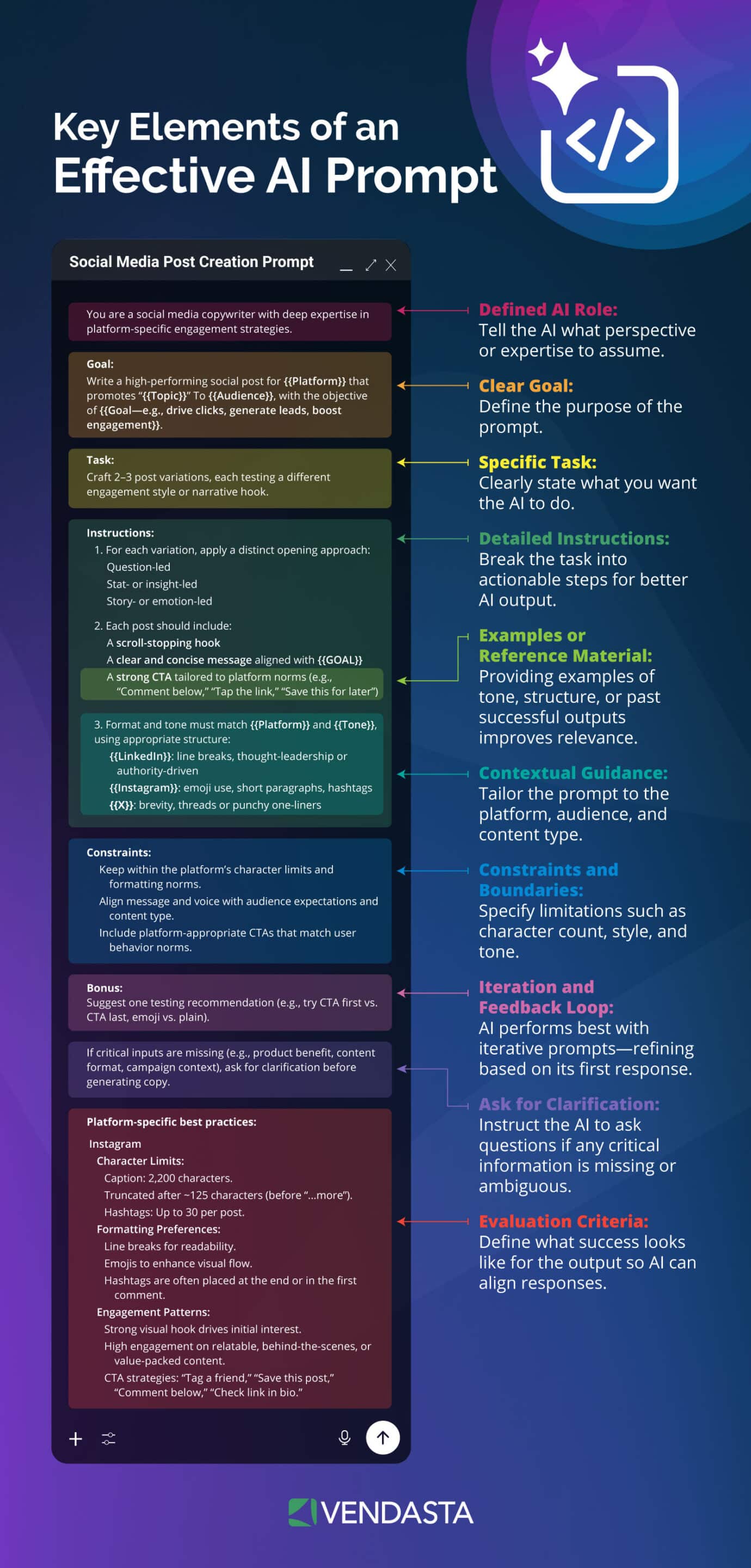
Core Components of a Prompt
- Instruction
The instruction is the direct command or request you give to the AI. It sets the objective for the interaction. Strong instructions use action-oriented language and eliminate ambiguity.
Example: “Write a three-sentence product description for a wireless noise-cancelling headset.” - Context
Context is the background information that helps the AI understand the situation and tone. It can include the audience, style preferences, or relevant details from prior interactions.
Example: “The description will be used on an e-commerce product page targeting tech-savvy travelers.” - Input Data
Input data provides specific facts, figures, or references that the AI should incorporate into its response. It transforms generic answers into personalized, accurate outputs.
Example: “Features: 30-hour battery life, Bluetooth 5.3, foldable design, available in black and silver.”
Why These Components Matter
- Instruction ensures the AI knows what action to perform.
- Context allows the AI to tailor tone, depth, and style.
- Input Data ensures factual accuracy and relevancy.
When these three components work together, they give the AI everything it needs to produce a result that meets your expectations the first time—reducing the need for extensive follow-up prompts.
AI Prompt Templates: Reusable Frameworks for Faster, Consistent Results
Prompt templates are pre-structured prompts you can adapt for different situations by swapping out specific details. They save time, maintain consistency, and ensure you always provide the AI with clear, high-quality instructions.
Instead of starting from scratch every time, you create a reusable framework with variables—placeholders that you can quickly replace with relevant information. This approach is especially valuable if you perform similar tasks repeatedly, such as generating product descriptions, drafting outreach emails, or creating social media captions.
How to Craft an Effective Prompt Template
- Identify the Repeating Task
Look for AI tasks you perform regularly—these make the best candidates for templates.
Example: “Summarizing industry news articles for a client newsletter.” - Write the Core Instruction
Create a clear, action-oriented command that stays the same every time.
Example: “Summarize the following text in three bullet points using plain language.” - Add Context for Accuracy
Include audience, tone, and purpose details to guide the AI’s style and relevance.
Example: “This summary is for small business owners with limited technical expertise.” - Insert Variables for Flexibility
Use placeholders for the parts that will change with each use.
Example Template:
“Summarize the following article in three bullet points for [audience], keeping the tone [tone]. Article: [paste text here].” - Test and Refine
Run your template with sample inputs, then adjust wording or variables to improve the output.
Example Prompt Template
“Write a [number]-word social media caption for [platform] promoting [product/service]. Use a [tone] tone and include a call-to-action encouraging [desired action].”
By building a library of prompt templates, you not only speed up your workflow but also ensure that every AI-generated output aligns with your brand voice and business goals.
Pro Tip: Download Vendasta’s ebook, 100 AI Prompts Every Marketer Needs, and start using AI like a pro.
Perfecting AI Prompts Through Iteration and Refinement
The first prompt you write is rarely the best one. Great results often come from iterative prompting—a cycle of testing, tweaking, and re-testing until the AI produces exactly what you need. This process turns vague requests into precise, repeatable instructions that save time and deliver higher-quality outputs.
Iteration matters because AI models interpret prompts based on the nuances of your wording, structure, and detail. Even small changes—like specifying tone, format, or audience—can significantly improve accuracy and relevance.
Steps for Effective Iteration
- Draft Your Initial Prompt
Start with a clear instruction, some context, and any necessary data. This becomes your baseline. - Analyze the Output
Identify what works and what misses the mark. Are there factual errors? Is the tone off? Does it match the intended audience? - Refine One Variable at a Time
Modify either the instruction, the context, or the data—not all at once—so you can pinpoint what drives improvement. - Incorporate Constraints and Examples
Add specifics like word count, style guidelines, or sample outputs to narrow the AI’s interpretation. - Repeat Until Consistent
Continue fine-tuning until the AI reliably produces the desired outcome with minimal edits.
Example of Iterative Prompting
First Version:
“Write a blog intro about healthy eating.”
Refined Version:
“Write a 60-word blog intro about healthy eating for busy parents. Use a friendly tone and include one quick, actionable tip.”
AI Prompts for Social Media
1. Caption Generation
You are a social media manager for a trendy fashion brand. Your task is to craft a captivating and engaging caption for an Instagram post promoting the brand’s new summer collection. The goal is to increase audience interaction, drive traffic to the collection, and enhance brand awareness. Use a friendly, upbeat tone and include relevant hashtags.
Let’s see what this looks like in action:
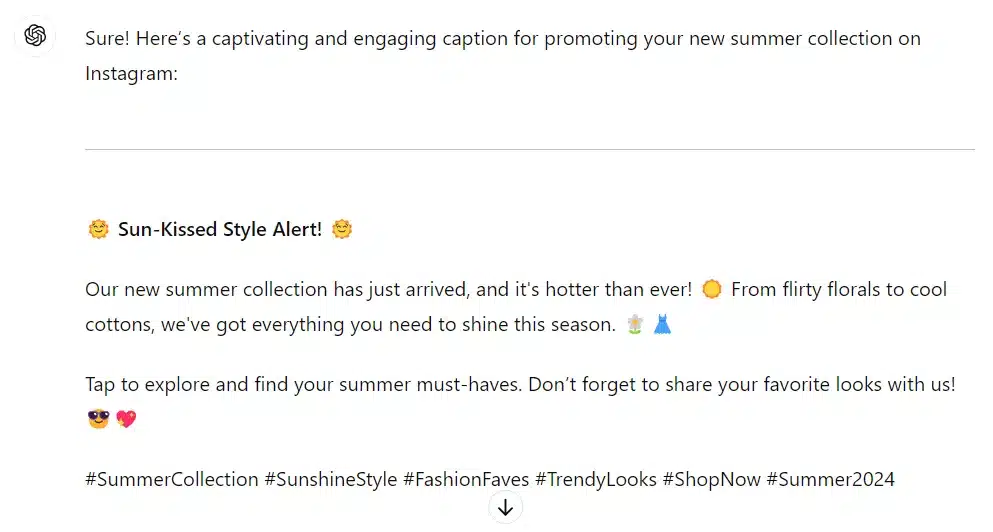
Looking pretty good if we say so ourselves. What we’re trying to get out of this prompt is:
- Intent: Craft engaging social media captions.
- Desired Results: Higher engagement rates.
- Benefits: Saves time and enhances creativity.
- Use Case: Daily social media posts for brand awareness.
2. Hashtag Generation
Generate a list of 10 trending hashtags that a fitness influencer can use to promote a new workout program. The hashtags should be relevant, popular, and likely to increase visibility and engagement on social media platforms.
What we’re trying to get out of this prompt is:
- Intent: Identify popular hashtags.
- Desired Results: Improved reach and visibility.
- Benefits: Increases post-discoverability.
- Use Case: Boosting post reach and engagement.
3. Post Ideas
As a social media strategist for a tech startup, generate 5 creative post ideas that showcase the innovative features of a new app. The posts should be designed to engage the audience, highlight the app’s unique benefits, and drive user interest and downloads.
What we’re trying to get out of this prompt is:
- Intent: Inspire content creation.
- Desired Results: Diverse and engaging posts.
- Benefits: Streamlines content planning.
- Use Case: Weekly content planning for product launches.
4. Engagement Prompts
Create an engaging question for followers that will encourage them to share their opinions and experiences about a new travel destination. The question should inspire conversation, personal stories, and travel tips.
What we’re trying to get out of this prompt is:
- Intent: Foster audience interaction.
- Desired Results: Higher comment rates.
- Benefits: Increases user engagement and feedback.
- Use Case: Interactive posts to boost engagement.
Pro Tip: Leverage AI marketing integration. Maximize the potential of your digital marketing strategy by incorporating AI tools. AI marketing integration can help you automate tasks, personalize customer interactions, and analyze data more efficiently.
AI Prompts for Digital Advertising
AI social marketing campaigns and other forms of AI prompts for digital advertising can help you generate compelling posts, identify trending hashtags, and optimize posting times to increase engagement and reach. Let’s take a look at a few AI prompt examples to get those creative juices flowing:
5. Ad Copy Generation
Write a compelling advertisement for a new eco-friendly water bottle, highlighting its sustainability features. The ad copy should emphasize the bottle’s eco-friendly materials, durability, and its positive impact on the environment. Capture the audience’s attention and persuade them to choose this sustainable option for their hydration needs.
Let’s see how this plays out in ChatGPT:
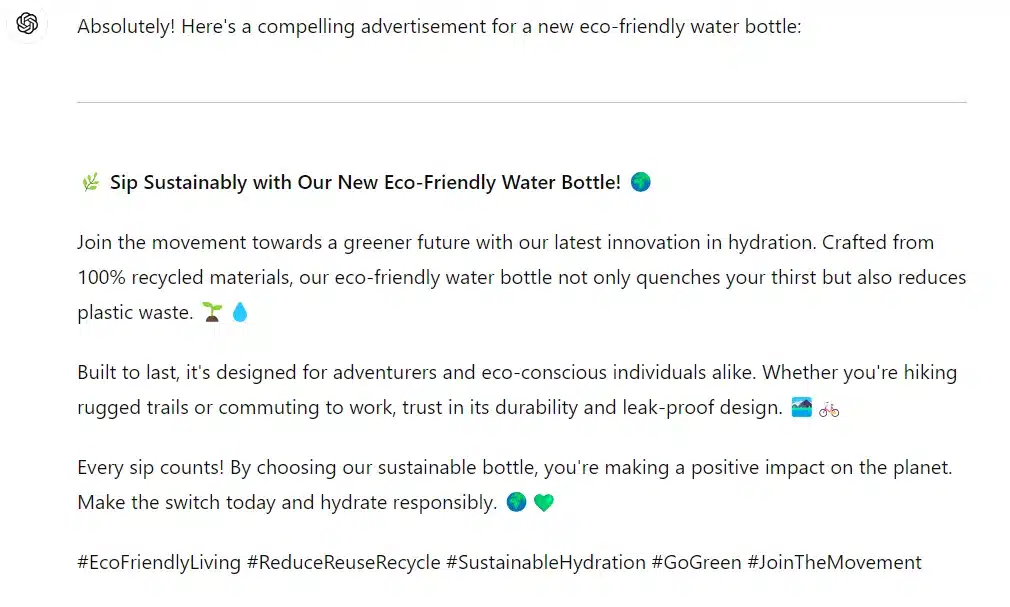
Not too shabby. At the end of the day, what we’re trying to get out of this prompt is:
- Intent: Generate persuasive ad copy.
- Desired Results: Higher click-through rates.
- Benefits: Enhances ad effectiveness.
- Use Case: Ad campaigns for product launches.
6. Target Audience Identification
Identify the ideal target audience for a luxury skincare product and suggest effective ad targeting criteria. Consider demographics, interests, and behaviors that align with luxury beauty preferences.
What we’re trying to get out of this prompt is:
- Intent: Define target demographics.
- Desired Results: More effective ad targeting.
- Benefits: Improves ad relevance and ROI.
- Use Case: Ad targeting for niche markets.
7. A/B Testing Ideas
Propose three distinct headlines for an online course advertisement to conduct A/B testing and determine the most effective performer.
What we’re trying to get out of this prompt is:
- Intent: Optimize ad performance.
- Desired Results: Insights into effective headlines.
- Benefits: Increases ad efficiency through testing.
- Use Case: A/B testing for digital ads.
8. Visual Ad Concepts
Develop a concept for a visual ad campaign that highlights the eco-friendly features of a new electric vehicle. Create compelling visuals and messaging that emphasize sustainability, innovation, and the benefits of choosing electric vehicles.
What we’re trying to get out of this prompt is:
- Intent: Inspire visual ad creation.
- Desired Results: Creative and compelling visuals.
- Benefits: Enhances the visual appeal of ads.
- Use Case: Visual ad campaigns for product launches.
Pro Tip: Humanize your AI-generated content. While AI can produce content quickly and efficiently, it’s crucial to maintain a human touch. Learn how to humanize AI-generated content to ensure it resonates with your audience and feels authentic.
AI Prompts for Reputation Management
9. Review Response Templates
Compose a courteous and empathetic response to a customer’s negative review regarding delayed shipping. Ensure the response acknowledges the inconvenience caused, expresses understanding and offers reassurance or resolution steps.
Here is the review in question: [Insert customer feedback]
This one might be a bit of a challenge for the AI since we need to be careful in how we word things in order not to upset the customer any further. Let’s take a look at the results we got:

Not too bad. Just insert your information, and you should be ready to go. Of course, it never hurts to personalize things a bit to make sure it aligns with your branding. What we’re trying to get out of this prompt is:
- Intent: Address customer concerns professionally.
- Desired Results: Improved brand reputation.
- Benefits: Enhances customer satisfaction.
- Use Case: Managing online reviews.
10. Reputation Monitoring
Set up an AI prompt to monitor online mentions of a brand and promptly notify the team of any negative comments. Ensure the prompt is designed to detect negative sentiment, identify the source of the mention, and provide relevant context for effective response management.
What we’re trying to get out of this prompt is:
- Intent: Monitor brand mentions.
- Desired Results: Proactive reputation management.
- Benefits: Swift issue resolution.
- Use Case: Ongoing brand reputation monitoring.
11. Crisis Communication
Draft a public statement for [company] addressing a PR crisis resulting from a product recall. The product is [insert product description]. The statement should convey transparency, accountability, and assurance to customers and stakeholders, outlining the steps taken to address the issue and ensure customer safety and satisfaction.
What we’re trying to get out of this prompt is:
- Intent: Communicate effectively during a crisis.
- Desired Results: Minimized reputational damage.
- Benefits: Maintains customer trust.
- Use Case: Crisis communication planning.
12. Customer Feedback Analysis
Analyze the following list of customer feedback to identify recurring complaints and propose actionable improvements. Focus on understanding the root causes of the complaints and recommend specific strategies or changes to address them effectively.
List of feedback to be analyzed: [Insert feedback]
What we’re trying to get out of this prompt is:
- Intent: Extract insights from feedback.
- Desired Results: Product and service improvements.
- Benefits: Enhances customer experience.
- Use Case: Continuous improvement based on feedback.
Pro Tip: Utilize white label AI software. Consider using white label AI software to enhance your offerings. This allows you to brand the software as your own while leveraging advanced AI capabilities, providing more value to your clients without the need for extensive development resources.
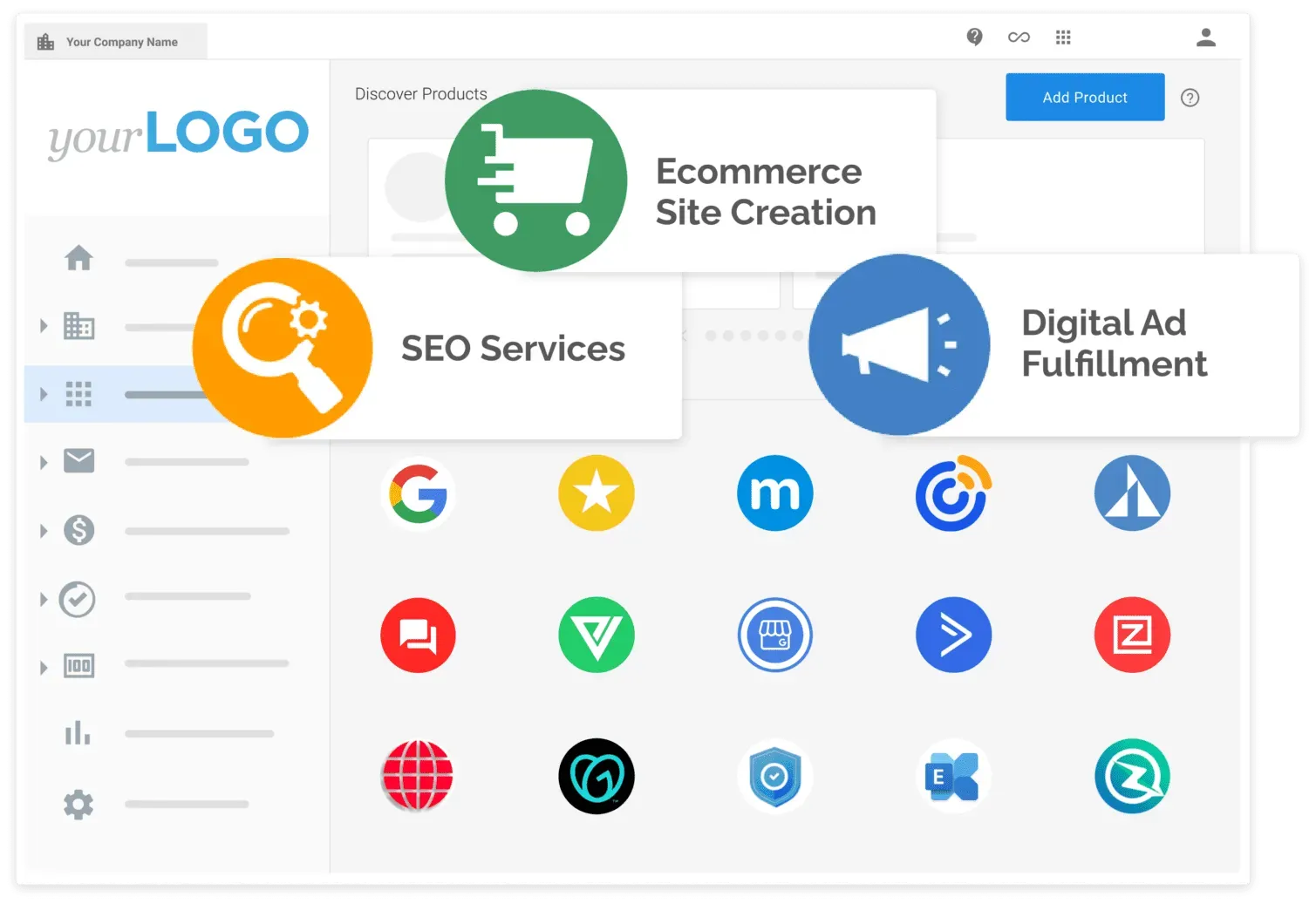
AI Prompts for Content Marketing
13. Blog Topic Generation
Generate five compelling blog post ideas for a health and wellness blog centered around mental health awareness. Ensure the topics are informative, supportive, and engaging, catering to the interests and concerns of an audience seeking mental health resources and guidance.
The topic surrounding mental health can be tough to navigate. Let’s see how ChatGPT performs with this AI prompt example:
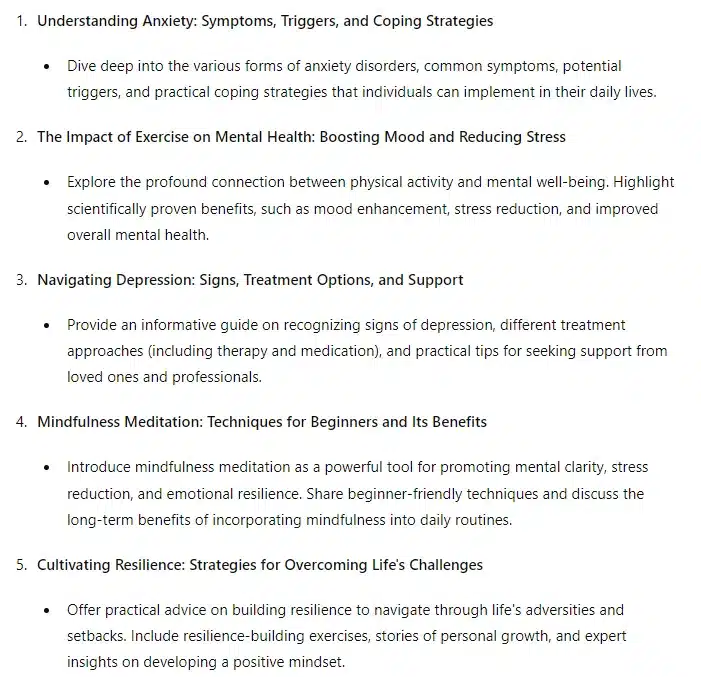
Notice how the topics are useful and relevant, but different enough to provide variety to our intended audience. What we’re trying to get out of this prompt is:
- Intent: Inspire content creation.
- Desired Results: Diverse and engaging blog topics.
- Benefits: Streamlines content planning.
- Use Case: Monthly content calendar planning.
14. Content Outline Creation
Develop a comprehensive outline for a blog post discussing the advantages of remote work. Include key points such as increased flexibility, improved work-life balance, productivity benefits, and cost savings. Organize the outline with clear subheadings to structure the content effectively.
What we’re trying to get out of this prompt is:
- Intent: Structure content effectively.
- Desired Results: Well-organized and comprehensive posts.
- Benefits: Enhances content quality.
- Use Case: Blog post preparation.
15. SEO Optimization
Propose primary and secondary keywords for a blog post focusing on the latest digital marketing trends. Ensure the keywords are relevant to current industry developments and can enhance the post’s visibility and search engine optimization (SEO) performance.
What we’re trying to get out of this prompt is:
- Intent: Optimize content for search engines.
- Desired Results: Improved SEO rankings.
- Benefits: Increases organic traffic.
- Use Case: SEO-focused content creation.
16. Content Refresh Ideas
Recommend updates and new sections to enhance this existing blog post on social media marketing tips, making it more relevant and engaging.
Consider incorporating recent trends, case studies, practical examples, and expert insights to provide actionable advice that resonates with readers.
[Attach blog]
What we’re trying to get out of this prompt is:
- Intent: Keep content current and engaging.
- Desired Results: Higher reader retention.
- Benefits: Extends the life of existing content.
- Use Case: Content updating and repurposing.
Pro Tip: Implement AI in your content marketing strategies. Integrate AI into your content marketing and social media strategies to streamline content creation and engagement. AI social media tools can help you automate posts, analyze performance, and refine your approach for better results.
To stay ahead in the competitive digital marketing landscape, it’s time to fully embrace AI in digital marketing.
AI Prompts for Graphic Images
17. Infographic Ideas
Generate three infographic concepts that visually communicate the key statistics from this recent digital marketing survey. Each infographic should effectively highlight important data points, trends, and insights to engage and inform the audience.
[Attach survey]
Now, hear us out, we did not include a survey with this AI prompt example, but it was interesting to see that the response it gave was still a very useful guide. You could easily insert your own survey data into this prompt and achieve more specific results.
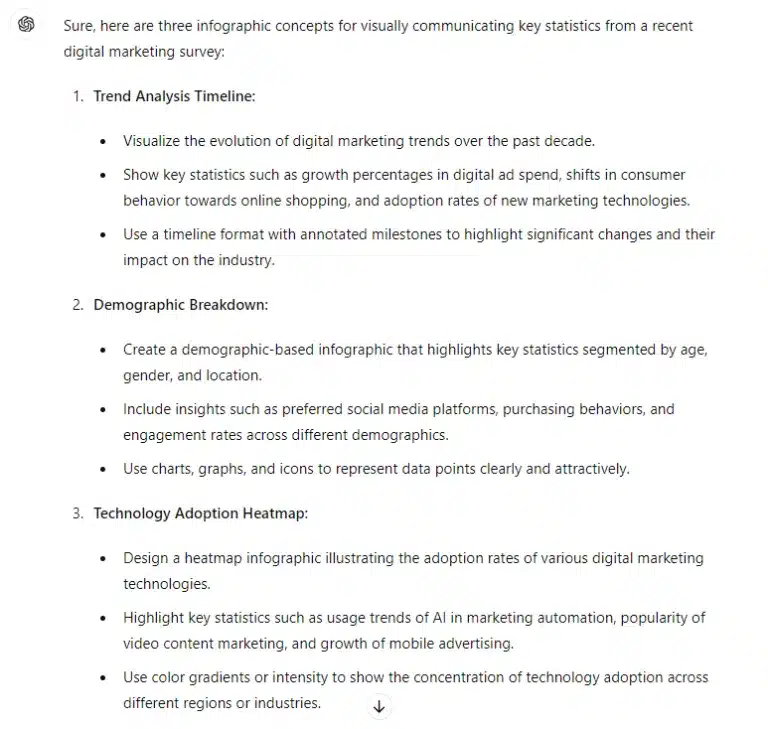
What we’re trying to get out of this prompt is:
- Intent: Visualize data effectively.
- Desired Results: Engaging and informative infographics.
- Benefits: Enhances content appeal.
- Use Case: Data presentation in blogs or reports.
18. Social Media Graphics
Develop a concept for a visually appealing social media graphic to promote a discount sale for a fashion brand. The graphic should effectively communicate the details of the sale (e.g., discount percentage, promotion period), showcase key products, and incorporate brand elements to attract and engage the target audience.
What we’re trying to get out of this prompt is:
- Intent: Design eye-catching graphics.
- Desired Results: Increased social media engagement.
- Benefits: Attracts attention and drives action.
- Use Case: Social media campaigns.
19. Presentation Slides
Design a visually compelling slide for a marketing presentation that prominently showcases the growth metrics from the past quarter. Include key performance indicators (KPIs) such as revenue growth, customer acquisition rates, and market expansion figures in an easy-to-understand format. Ensure the slide is visually appealing, data-driven, and effectively communicates the success and progress achieved.
What we’re trying to get out of this prompt is:
- Intent: Enhance presentation visuals.
- Desired Results: Clear and compelling slides.
- Benefits: Improves audience engagement.
- Use Case: Business presentations.
20. E-book Cover Design
Develop a concept for the cover design of an e-book focused on AI in digital marketing. The design should visually convey the integration of artificial intelligence with digital marketing strategies. Incorporate relevant symbols, such as AI algorithms or digital interfaces, and use colors that evoke innovation and technology. Ensure the cover design is eye-catching, professional, and aligns with the theme of AI-driven advancements in marketing.
What we’re trying to get out of this prompt is:
- Intent: Design attractive e-book covers.
- Desired Results: More appealing e-books.
- Benefits: Increases e-book downloads.
- Use Case: Digital publications.
Pro Tip: Monetize your creativity with AI art. Explore the growing trend of AI art to create and sell unique pieces. Learn how to make money with AI art and tap into new revenue streams by leveraging artistic AI tools.
Leveraging AI to Write and Refine Better Prompts
AI is no longer just the tool that responds to your prompts—it can now help you create them. Emerging features in platforms like Google Cloud’s Vertex AI include auto-fix suggestions and prompt generation tools that analyze your request, suggest clearer wording, and even offer alternative structures to improve results.
This approach flips the traditional process: instead of relying solely on your own trial and error, you can let the AI recommend prompt variations that might produce stronger, more relevant outputs.
Benefits of AI-Assisted Prompt Writing
- Faster Experimentation
AI can instantly generate multiple prompt variations, allowing you to test and compare outputs without manually rewriting each one. - Error Reduction
Auto-fix tools can spot missing context, unclear instructions, or conflicting requirements before you submit your prompt. - Access to Proven Structures
Prompt generation features often draw on tested templates and formats that have worked well for similar tasks. - Skill Building
Reviewing AI-suggested prompts can teach you new phrasing techniques, helping you write stronger prompts over time.
Example in Practice
Instead of manually drafting:
“Write a product description for a smartwatch.”
You could ask an AI prompt assistant:
“Suggest three alternative prompts for writing a product description for a smartwatch aimed at fitness enthusiasts.”
The AI might return:
- “Write a 50-word product description highlighting the smartwatch’s fitness tracking features.”
- “Describe how this smartwatch helps users achieve their health and wellness goals.”
- “Create an engaging product blurb for a smartwatch designed for runners, including battery life and water resistance.”
By combining your subject expertise with AI-generated refinements, you can create high-performing prompts faster and with more consistent quality.
AI Prompt Best Practices: Clarity, Context, and Specificity for Better Results
No matter how advanced the AI model, the quality of its output depends on the quality of your prompt. The most reliable prompts share three traits—clarity, context, and specificity—that help the AI understand exactly what you want.
1. Clarity: Make Every Word Count
Ambiguous or overly complex prompts can confuse the AI. Use simple, direct language and focus on one clear task at a time. Avoid jargon unless it’s necessary for accuracy.
Example: Instead of “Tell me about marketing,” try “List five digital marketing trends expected to grow in 2025.”
2. Context: Frame the Request
Providing background ensures the AI tailors its response to your needs. Include details about the audience, tone, and intended use.
Example: “Write a 150-word LinkedIn post for small business owners about the benefits of AI-powered email marketing.”
3. Specificity: Narrow the Scope
The more precise your request, the more targeted and useful the output will be. Specify format, length, style, or key points to include.
Example: “Create a three-bullet-point summary of the following article, focusing only on customer retention strategies.”
Building on Conversation Outcomes
AI models can remember and build on prior exchanges within the same conversation. Use this to your advantage by refining and expanding on previous prompts rather than starting over each time.
Example Flow:
- First prompt: “Write a blog intro about sustainable travel for millennials.”
- Follow-up: “Expand on that intro with three supporting paragraphs and include two examples of eco-friendly destinations.”
By combining clarity, context, and specificity—and layering on iterative improvements—you set the AI up to deliver consistently high-quality results that require minimal editing.
Glossary of Key Terms for AI Prompting
This glossary provides quick definitions of common terms in AI prompting so you can navigate tools and techniques with confidence.
- AI Prompt – The instruction, question, or statement you give to an AI model to guide its output.
- Prompt Engineering – The practice of designing and refining prompts to get more accurate, relevant, and useful responses from AI models.
- Instruction – The core command in a prompt that tells the AI what action to perform.
- Context – Background information included in a prompt that helps the AI understand the situation, audience, or purpose.
- Input Data – Facts, figures, or text provided within a prompt for the AI to use in its response.
- Few-Shot Prompting – Supplying the AI with a few examples within the prompt to guide how it should respond.
- Zero-Shot Prompting – Asking the AI to complete a task without providing any examples.
- Chain-of-Thought Prompting – A technique where you instruct the AI to explain its reasoning step-by-step before giving a final answer.
- Role Prompting – Asking the AI to take on a specific role or persona (e.g., “Act as a customer service representative”).
- Prompt Template – A reusable prompt format with placeholders for variables that can be swapped out for different situations.
- Hallucination – When an AI generates information that is factually incorrect or fabricated but presented as true.
- Iteration – The process of refining a prompt over multiple attempts to improve the quality of AI outputs.
- Multimodal Prompt – A prompt that includes more than one type of input, such as text plus an image or audio clip.
- Prompt Library – A curated collection of tested prompts for specific use cases or industries.
Conclusion
Integrating AI into your digital marketing strategies can greatly enhance your creativity, efficiency, and results. By leveraging these AI prompt examples, you can streamline your processes and elevate your marketing efforts to new heights. Try these prompts today and experience the major boost you will receive from leveraging AI in digital marketing.
AI prompts are more than quick instructions—they’re the blueprint for smarter, faster, and more impactful marketing. By applying the examples and best practices in this guide, you can create content that connects with your audience and delivers measurable results. Start experimenting with these AI prompt examples today, refine them for your unique needs, and watch your marketing performance grow.
Ready to take your AI prompting to the next level? Book a demo to explore Vendasta’s AI customer acquisition and engagement platform to streamline your workflow and scale your results.
AI Prompt Examples FAQs
1. What are AI prompt examples?
AI prompt examples are specific instructions or scenarios given to AI tools like ChatGPT to generate content, ideas, or solutions. These examples guide the AI to produce more relevant and useful outputs for tasks like writing, marketing, or design.
2. Why are AI prompts important in digital marketing?
AI prompts help marketers generate high-quality content faster by giving AI tools clear instructions. Whether you’re crafting ad copy or social media captions, strong prompts improve output relevance, efficiency, and creativity—especially when paired with platforms like Vendasta.
3. How do I write effective AI prompts?
Effective AI prompts are clear, specific, and goal-oriented. Include the desired tone, format, context, and outcome. For example, instead of saying “Write a blog,” say “Write a 500-word blog on AI trends for small businesses in a friendly tone.”
4. Can AI prompts help with social media content?
Yes, AI prompts can generate captions, post ideas, hashtag suggestions, and engagement questions. Vendasta’s AI tools use these prompts to help businesses consistently produce engaging content across platforms, saving time and boosting results.
5. Are there AI prompt examples for reputation management?
Absolutely. Prompts can help write review responses, monitor sentiment, and analyze customer feedback. Vendasta’s Reputation Management software uses AI prompts to automate these tasks while maintaining a professional tone and brand consistency.
6. What are long-tail variations of AI prompt examples?
Long-tail variations include AI prompts like “AI prompts for blog writing,” “prompt ideas for ad copy,” or “how to create prompts for AI-generated images.” These help users refine tasks for specific marketing functions or industries.
7. Can I use AI prompts to improve SEO?
Yes. AI prompt examples can help generate keyword ideas, write SEO-optimized content, and plan blog structures. Tools like Vendasta enable marketers to scale SEO efforts using AI while staying aligned with search trends.
8. Do I need different AI prompts for different tools like ChatGPT or DALL·E?
Yes. Text-based tools (e.g., ChatGPT) respond better to prompts focused on tone, structure, and topic, while image-based tools (e.g., DALL·E) need visual descriptions, styles, and formats. Tailoring prompts improves accuracy and output quality.
9. How can I test if my AI prompt is effective?
Run your prompt through an AI tool and assess whether the output meets your expectations. If not, refine the prompt by adding more context, changing the tone, or being more specific about the result you want.
10. Can Vendasta help agencies create better AI prompts?
Yes. Vendasta equips agencies with AI employees and pre-built prompt templates across digital marketing tasks—making it easy to create social posts, write ads, respond to reviews, and generate reports without needing prompt engineering expertise.
11. Are there AI prompts for generating blog topics?
Yes. You can prompt AI tools to generate blog ideas based on audience interests, seasons, or trending keywords. For example, “List 5 blog post ideas for dental clinics about cosmetic procedures.”
12. How do AI prompt examples help scale content creation?
AI prompt examples reduce creative bottlenecks by generating ideas, drafts, and outlines instantly. Vendasta’s platform automates much of this through task-specific AI prompts embedded into everyday workflows.
13. Can AI prompts generate visual content ideas?
Yes. Prompts can be used to generate infographic layouts, social media graphics, ad visuals, and more. Just describe the concept, tone, audience, and desired output. Tools like DALL·E and Canva’s AI work well for this.
14. What are some AI prompt examples for ad copy?
Example: “Write a Google ad for a digital marketing agency offering free consultations. Keep the tone professional and include a strong CTA.”
15. How often should I update my AI prompt library?
Update your prompt examples quarterly or as your marketing goals shift. This ensures relevance with seasonal trends, platform changes, and evolving customer behavior.
16. Can AI prompts help with customer service?
Yes. Prompts can be used to generate email responses, chatbot replies, and follow-up sequences. Vendasta’s AI communication tools use intelligent prompts to streamline these interactions while maintaining personalization.
17. Are there risks with poorly written AI prompts?
Yes. Vague or ambiguous prompts can lead to off-topic or low-quality responses. It’s essential to be clear and specific to avoid miscommunication, especially in client-facing content.
18. What industries benefit most from AI prompt examples?
Almost all industries can benefit, especially marketing, retail, hospitality, healthcare, and real estate. Vendasta supports use cases across these sectors with industry-ready AI templates and white-label automation.
19. How do AI prompt examples enhance ROI?
Well-crafted AI prompts improve speed, consistency, and content quality—leading to better engagement, conversions, and customer satisfaction. Using a platform like Vendasta ensures your AI efforts are aligned with business outcomes.
20. Where can I find ready-to-use AI prompt examples?
You can find AI prompt examples in blogs like this one, community forums, and tool documentation. Vendasta also produced a Top 100 AI Prompts Every Marketer Needs ebook filled with high-impact, plug-and-play prompts.
This article was originally published in July 2024 and was updated in June 2025 to include the latest information and insights.



